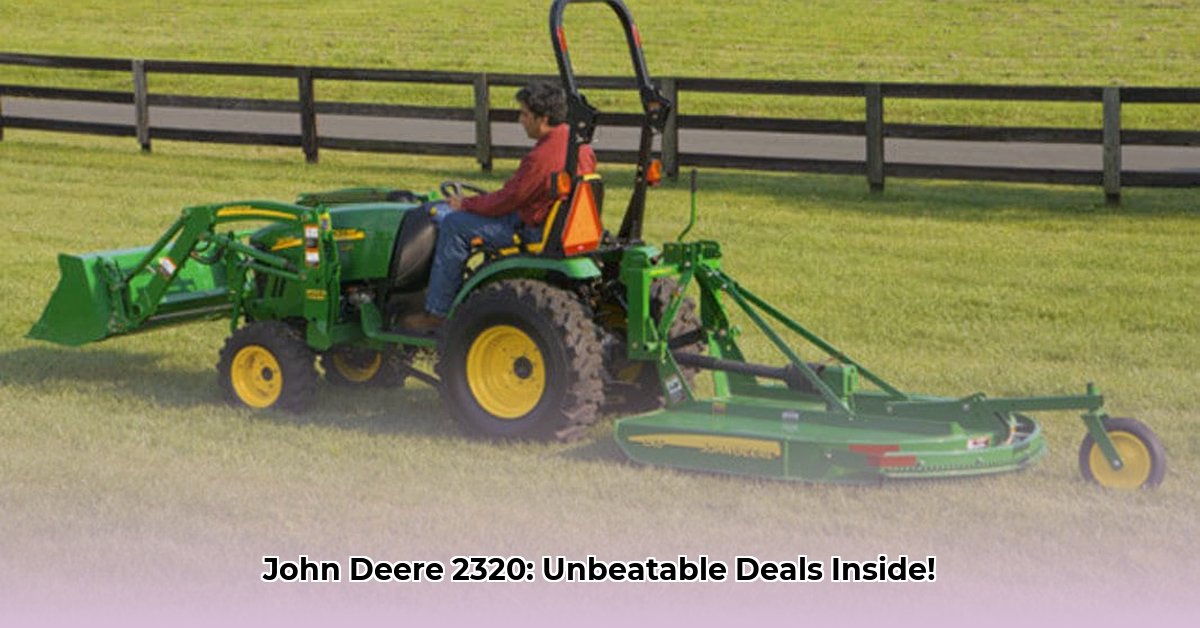
John Deere 2320 Tractor: A Comprehensive Buyer's Guide
Considering a used John Deere 2320 tractor? This guide provides the information you need to make a smart purchase, whether you're a seasoned farmer or a first-time buyer. We'll cover key specifications, market analysis, potential maintenance costs, and a pre-purchase checklist to ensure you get the best value for your investment. For a comparison, check out the specs on this John Deere 245.
Understanding the John Deere 2320
Manufactured between 2006 and 2011, the John Deere 2320 is a compact utility tractor known for its reliability and versatility. Its 24.1 horsepower (gross) engine and hydrostatic transmission make it suitable for a range of tasks on smaller properties, from mowing and tilling to light hauling. However, its age requires careful consideration of potential maintenance needs and technological limitations.
Is a hydrostatic transmission always better? While famously smooth and easy to operate, remember that regular maintenance is crucial to prevent costly repairs.
Key Features and Specifications
Understanding the 2320's specifications is vital for comparing it to other tractors and assessing its suitability for your needs.
- Engine: 24.1 hp (gross) engine, 18 hp PTO (power take-off). Sufficient for many tasks but may lack power for heavier applications compared to newer models.
- Transmission: Hydrostatic transmission; smooth operation, simple speed control via pedals. Note potential for increased maintenance if not properly cared for.
- Hydraulics: 2.6-gallon capacity. Adequate for many attachments, but limitations exist for sizable implements or simultaneous operations.
- Three-Point Hitch: Standard feature for attaching implements like mowers and tillers. Inspect this carefully; wear and tear is common with age.
Market Analysis: Navigating the Used Tractor Market
Prices for used John Deere 2320s vary greatly ($9,000 - $21,000+), influenced by:
- Operating Hours: Lower hours usually mean higher price, but always check for meter tampering.
- Condition: A well-maintained tractor commands a premium. Look for signs of neglect and damage.
- Attachments: Included implements (e.g., front-end loader) significantly increase value.
- Seller Reputation: Check online reviews before committing to a purchase.
The lack of standardized grading necessitates careful scrutiny of seller descriptions and detailed questions.
Pros and Cons of a Used John Deere 2320
Pros:
- Reliability: John Deere's reputation for durability gives peace of mind.
- Relatively Simple Maintenance: Easier and potentially cheaper to maintain than more complex models.
- Good Value (Potentially): A well-maintained example can be a sound investment.
- Versatile Implement Compatibility: The three-point hitch supports a wide range of tasks.
Cons:
- Age & Technology: Older technology limits features and fuel efficiency; expect increased maintenance needs compared to newer models.
- Part Availability: While parts are still available, sourcing may become more challenging and costly over time.
- Higher Repair Costs (Potential): Older equipment inherently carries a higher risk of repairs and associated expenses.
- Fuel Efficiency: Older engines tend to be less fuel-efficient than newer models.
Your Pre-Purchase Checklist: A Step-by-Step Guide
- Thorough Inspection: Examine every component visually. Look for wear, leaks, and damage.
- Service History Review: Request comprehensive maintenance records from the seller.
- Test Drive: Operate the tractor to assess its performance and identify any potential issues.
- Ask Questions: Prepare a detailed list of questions about repairs, maintenance, etc.
- Price Comparison: Research competitor prices to ensure you're getting a fair deal.
Cost of Ownership Analysis: Budgeting for Long-Term Expenses
Realistic budgeting is crucial. Factor in:
- Annual Maintenance: Expect $750-$1500 annually (depending on usage and condition) for routine servicing, fluid changes, and filter replacements.
- Repair Contingency: Set aside a significant sum for unforeseen breakdowns.
- Part Sourcing: Older parts can be expensive or difficult to find.
- Depreciation: The tractor's value will depreciate over time.
Alternatives Worth Considering
While a used John Deere 2320 is a strong contender, exploring newer compact tractors from Kubota, Mahindra, or other manufacturers is recommended. They offer improved fuel efficiency, advanced technology and may reduce long-term maintenance costs, though at a higher initial purchase price.
Conclusion: Making an Informed Decision
Buying a used John Deere 2320 can offer significant savings, but thorough research, a pre-purchase inspection, and realistic budgeting are essential. Use this guide to navigate the process effectively.
Three Pivotal Points:
- A comprehensive pre-purchase inspection is paramount to avoid hidden problems and costly repairs.
- Budget realistically for annual maintenance and potential repairs, and factor in the tractor's depreciation.
- Compare prices from different sources to ensure you get a competitive deal.